OREGON TRAIL
ELECTRIC COOPERATIVE

Academic Scholarship Applications Closing Soon
OTEC Board Election Nominations
Healthy Communities Series: Spotlight on Education

OREGON TRAIL
ELECTRIC COOPERATIVE

Academic Scholarship Applications Closing Soon
OTEC Board Election Nominations
Healthy Communities Series: Spotlight on Education
March 2024 • Volume 72, No. 3
CEO Michael Shepard
SENIOR VP OF CONTENT Leon Espinoza
EDITORIAL DIRECTOR Mike Teegarden, CCC
DEPUTY EDITORIAL DIRECTOR
Noble Sprayberry
SENIOR EDITOR Jennifer Paton, CCC
ASSISTANT EDITORS Chasity Anderson, CCC; Victoria Hampton, CCC, David Herder CCC
ASSOCIATE EDITORS
Valeri Pearon, Nina Todea
PUBLICATIONS PRODUCTION SR. MANAGER
Elizabeth Beatty
PUBLICATIONS COORDINATOR
Alyssa McDougle
Ruralite (USPS 397-460) is published monthly for members for $4.83 per year, plus postage, by Pioneer Utility Resources Inc., 5625 NE Elam Young Pkwy. Ste. 100, Hillsboro, OR 97124—a not-for-profit Oregon cooperative corporation—to serve the communication needs of 47 consumer-owned electric utilities in Oregon, Washington, Alaska, Idaho, Nevada and California. Preferred periodical postage paid at Hillsboro, Oregon, 97123 and additional mailing offices. © 2024 Pioneer Utility Resources. All rights reserved. Reproduction in whole or in part without written permission is prohibited.
Postmaster: Send address changes to Ruralite, 5625 NE Elam Young Pkwy. Ste. 100, Hillsboro, OR 97124-6454
HOW TO CONTACT RURALITE
Subscription services:
Nonmember subscriptions $15 (U.S.) per year; $25 per year (foreign). Prepayment required. Allow 4-8 weeks for first issue. Be sure to identify which local edition you want to receive.
Address Changes:
Utility members, contact your local utility. Subscribers, call us at 503-357-2105 option 3 or email mailingdept@pioneer.coop.
Back issues:
Back issues and extra copies $3. Prepayment required. Supply is limited. Be sure to identify edition, month and year. Call first if ordering back issues to check availability.
To contact Ruralite: Ruralite magazine is published by Pioneer Utility Resources.
P.O. Box 1306, North Plains, OR 97133-1306; 503-357-2105; email: info@pioneer.coop. For more information, visit www.pioneer.coop.
DISPLAY ADVERTISING INQUIRIES
American MainStreet Publications
611 S. Congress Ave., Ste. 504 Austin, TX 78704
800-626-1181 or 512-441-5200

For supplemental and interactive content, search @Ruralite on your favorite social media sites.
I don’t know about you, but I am itching to get outside and get my hands dirty. As soon as the soil in my flower beds stops feeling like overly thickened pudding, I’m ready to purge the winter blahs—and the weeds that have sprouted.
I have a few new flower beds that will get my attention first. One area is a clean slate just waiting for inspiration and the right plants to transform it.

I’m a lazy gardener, favoring native perennials that require little care while providing vibrant color year after year. Over time, I want to fill in the open spaces with low-creeping plants that reduce the need for weeding. I’m not there yet, but this month’s gardening story gave me great ideas on ways to reach my goals while saving money. I haven’t grown plants indoors from seeds since my days in elementary school, but I’m excited to give it a try again.
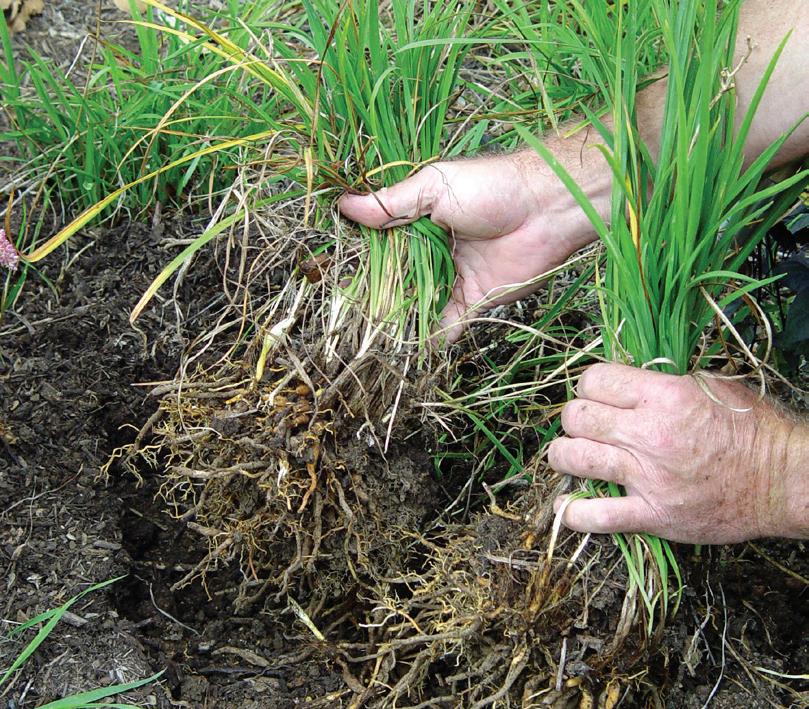
When the weather is too cold to work my flower beds, my family loves to play board games. We have an overflowing game closet. I was pretty excited when I ran across a company in Pahrump, Nevada, which helps game developers take their ideas to the finish line. You can read about it on Page 10. Maybe one of you will design the next must-have board game.
As we continue celebrating Ruralite’s 70th year, please look at the Before You Go story on Page 30. From time to time this year, we will share nuggets from some of the first issues of Ruralite magazine. This month, we feature new product descriptions and household tips that ran in December 1954.
Sincerely,
Mike Teegarden Editorial Director
Innovator leads the way to a successful board game design business Up Close, Page 10
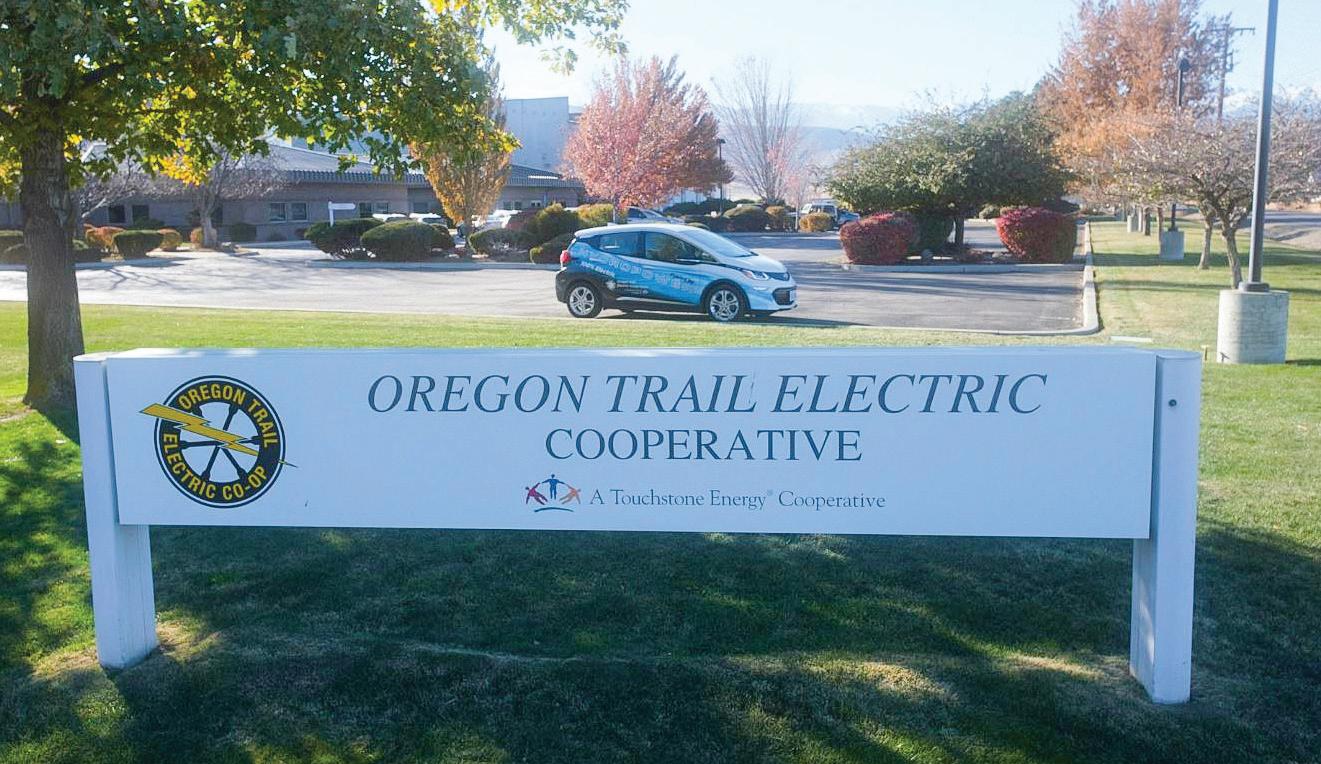
Oregon Trail Electric Cooperative is a private, not-for-profit electric cooperative owned by the members it serves. OTEC is governed by a board of directors elected by the membership and accountable to the membership.
Board members make business and policy decisions in setting the co-op’s direction. Directors are elected to serve three-year terms.
For 2024, the nominating committees nominated the following individuals for the OTEC Board of Directors:
• Position No. 4, Union County—Austin Bingaman, incumbent.
• Position No. 5, Baker County—Wayne Overton, incumbent.
• Position No. 6, Grant County—Gary Miller, incumbent.
The 2024 nominating committee members are:
• Union County—Donna Beverage, Cindy Edwards and Mary West.
• Baker County—Diana Brown, DeeDee Clarke and Fred Warner Jr.
• Grant County—Gail Enright, Mitch Saul and Bob Quinton.
OTEC members who live in these counties are still eligible to run for the 2024 board election via petition. A petition form may be requested by calling 541-524-2874. Nominations via petition are due by March 5, 2024. Find more information at otec.coop/annual-meeting-board-elections.
Election ballots—including candidate information—are mailed to OTEC member-owners at the beginning of April. Results of the election are announced at OTEC’s annual meeting May 4 in Burns. n
Per cooperative bylaws, Article III, Section 4: No less than 90 days before the annual meeting in which directors shall be elected, the Secretary of the Cooperative shall cause to be posted at the Cooperative’s principal place of business a list of the names of candidates selected by the nominating committee. Additional nominations may be made by petition filed with the Secretary not less than 60 days before the annual meeting. A petition shall contain the name of the candidate and the signatures of at least 50 members qualified to vote, and a request that the name of the candidate be placed on the ballot. All candidates so nominated must meet the director qualifications contained in Section 5 of this Article. Members may not nominate a candidate for director from the floor at the annual meeting.
Major ice storms swept across much of western Oregon in January, knocking out hundreds of power lines and creating widespread damage. At one point, more than 125,000 customers in Oregon and southwest Washington were without power.
It was immediately evident that help was needed to restore power as quickly and safely as possible.
One area hit especially hard was Lane County, where more than 5,000 members of Lane Electric Cooperative lost power.
On January 13, Lane Electric sent a call to other electric cooperatives for help with restoration efforts. Oregon Trail Electric Cooperative—along with several other electric cooperatives—answered the call and sent crews to assist.
This type of mutual aid among cooperatives is nothing new. From the beginning of the rural electrification program in the 1930s, electric co-ops have relied on one another to assist in times of disaster.
Because the national network of transmission and distribution infrastructure owned by electric cooperatives has been built to federal standards, line crews from any co-op in America can arrive on scene ready to provide emergency support, secure in their knowledge of the system’s engineering.
The priority of each local cooperative, including OTEC, is service to its own member-owners and the safety of the communities they serve. Before committing resources to mutual aid requests, each co-op ensures it has ample crews available for all local needs, including the cooperative’s outage mitigation.
When OTEC crews, including Travis Smart, arrived in Lane County, they saw the widespread damage first-hand.
“There was easily 2 inches of ice on everything,” Travis says. “When you stopped to listen, you could hear a constant cracking and popping of trees falling and limbs breaking. We spent the first couple of days just trying to keep more stuff from falling down. It’s hard to comprehend how
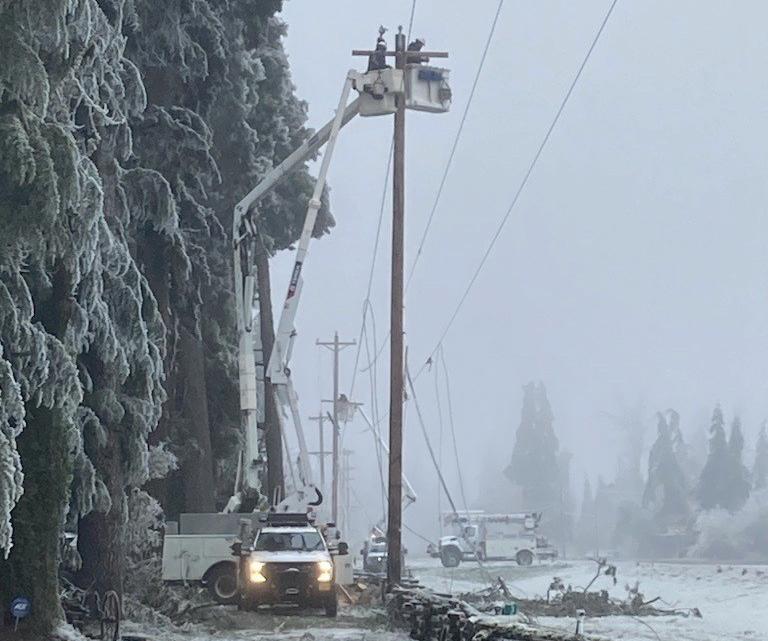
you could have every pole for a mile end up on the ground, or how the wire could rip a switch off the steel structure in a substation.”
Blake Eckstein, OTEC’s general foreman for the northern division, was also on-site.
“When there’s that much damage, everything shuts down,” he says. “It was almost like rolling into a ghost town.”
There was a silver lining to the situation, however.
“For a few days, there wasn’t any traffic to compete with so we could focus on recovery efforts,” Blake says.
Also responding was OTEC lineworker Chris Peppers, who was impressed with the reception from Lane Electric Cooperative.
“They were very organized and very helpful,” Chris says. “For as much damage as they had, things went very well. I feel we got a lot accomplished and made a
positive impact.”
Without the aid from OTEC and other co-ops, restoration efforts could have taken months. Thanks to joint efforts, most Lane Electric members had power restored within days.
“This shows the power of the cooperative network and exemplifies the cooperative principle of Cooperation Among Cooperatives,” says Lea Hoover, OTEC’s director of member and strategic services. “OTEC member-owners can rest assured that if we found ourselves in a similar emergency, co-ops from across Oregon would be on their way to Eastern Oregon to help us.”
Thanks to everyone from OTEC who answered the call: Travis, Blake, Chris, Orrin Ledgerwood, Randy Dowdy, Pat McCluskey, Dwight Howard, Rich Watkins, Tadd McCrae, Nick Simons, Devan Attleberger and Keaton Orton. n
awareness among young women about the opportunities available to them. Some even host day camps for teens in which they get a behind-the-scenes look at what’s involved with delivering power.
Beyond the highly visible roles such as linework, participants learn how people in areas as diverse as information technology, finance and environmental compliance are vital to utility operations.
Students aren’t the only target of such efforts. Desiree points to the priority the industry places on supporting career development for women. Mentorship programs and networking opportunities create platforms through which women can connect and share their experiences.
“These positive shifts need to be continuously reinforced with targeted outreach efforts, career awareness campaigns and support systems to enhance the entry points and career progression for women,” Desiree says.
Theresa sees a strong impact in the annual Women in Public Power Conference, a learning conference that provides developmental opportunities for women in five critical areas of success: knowing yourself, creating connections, managing communications, building confidence and strengthening resilience. It’s a room full of women supporting other women—from customer service representatives to general managers.
Theresa encourages others in the industry to attend as it’s a chance to network among other women.
Conferences are just one place to feel this camaraderie. NRECA’s Women in Power mentoring program for the electric co-op community provides support and resources to guide and empower women in their careers.
“Thanks to their Women in Power mentoring program, I have been able to network with several women across the country involved in the energy industry,” Duncan Valley Electric Cooperative CEO Kassi Mortenson says.
“(Through) the Women in Power mentoring program, I was matched with Charise Swanson, CEO of the New Mexico statewide organization, NMREC,” Kassi says. “Call it fate, but it could not have worked out more perfect. We were able to meet in person as DVEC is an associate member of the New Mexico group, and (we) have since developed a very beneficial mentor/mentee relationship.”
Nearly 20% of the nation’s co-op workforce is nearing retirement age during the next five years, which opens new opportunities in leadership roles at electric utilities across the country. Public power utilities pride themselves on offering stable jobs with opportunities for growth.
“Cooperatives are often recognized as ‘best place to work’ employers in their communities, offering competitive benefits, caring cultures and support for families,” Desiree says.
Strengthening inclusion and diversity is a commitment of public power utilites. Within this, women often advocate for fostering an environment where skills and expertise are valued among individuals.
“More and more women are becoming involved in the energy industry as utility leadership, boards of directors, lineworkers, engineers, etc.,” Kassi says. “Now it’s just a matter of everyone else getting used to it. Women in the energy industry are here to stay.” n






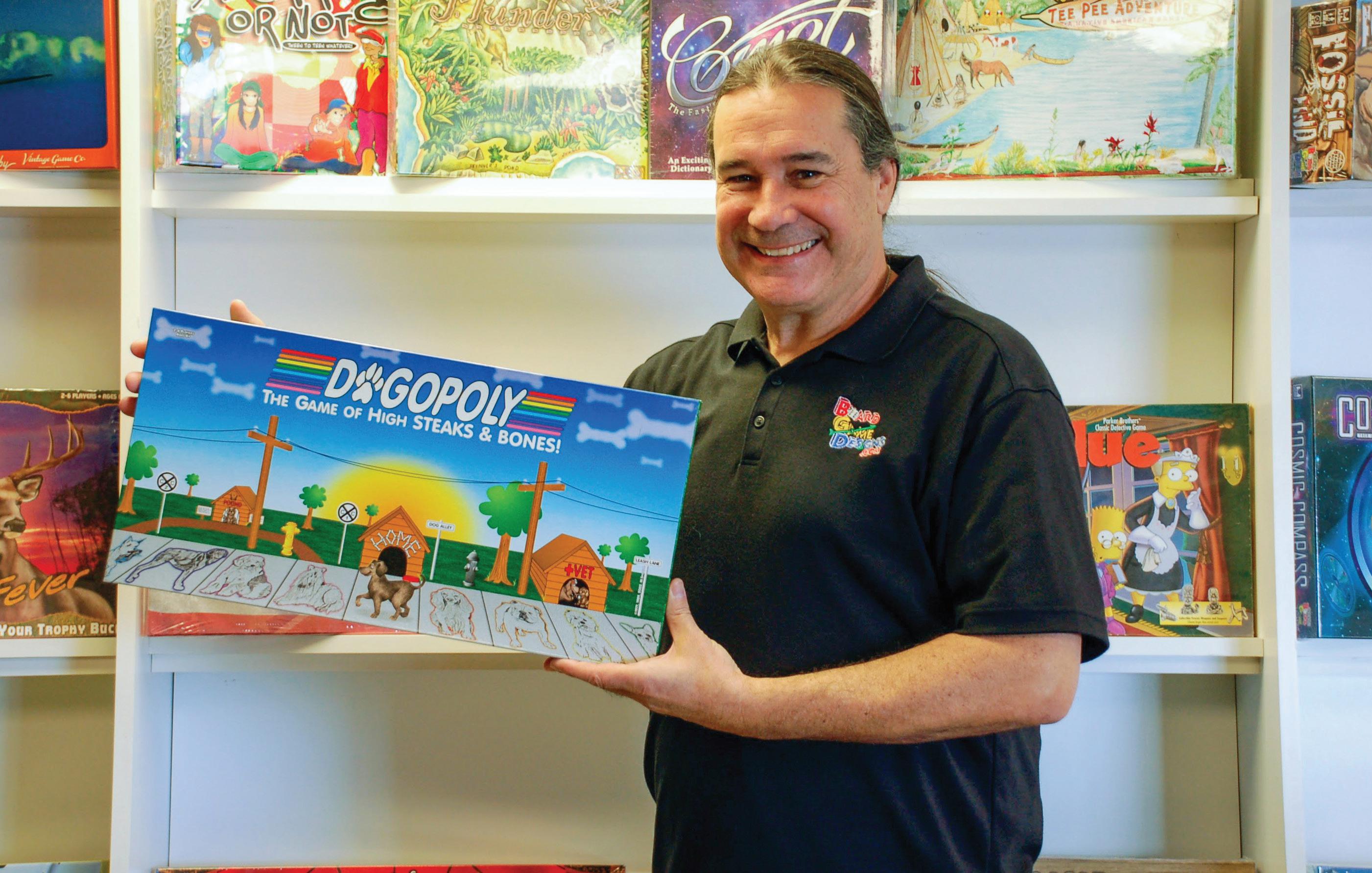
has operated out of this small town an hour outside of Las Vegas.
“When I moved to Pahrump, one of the pluses for us was the overhead,” Michael says. “We could actually have a building where we could do warehousing and order fulfillment.”
Looking through the rows of games Michael has helped create, it is apparent no two designs look alike. Vintage games are washed in sepia with old photographs on display while contemporary designs use eyecatching graphics and vibrant cartoon characters. According to Michael, he aims to keep singularity and longevity in mind when designing a game.
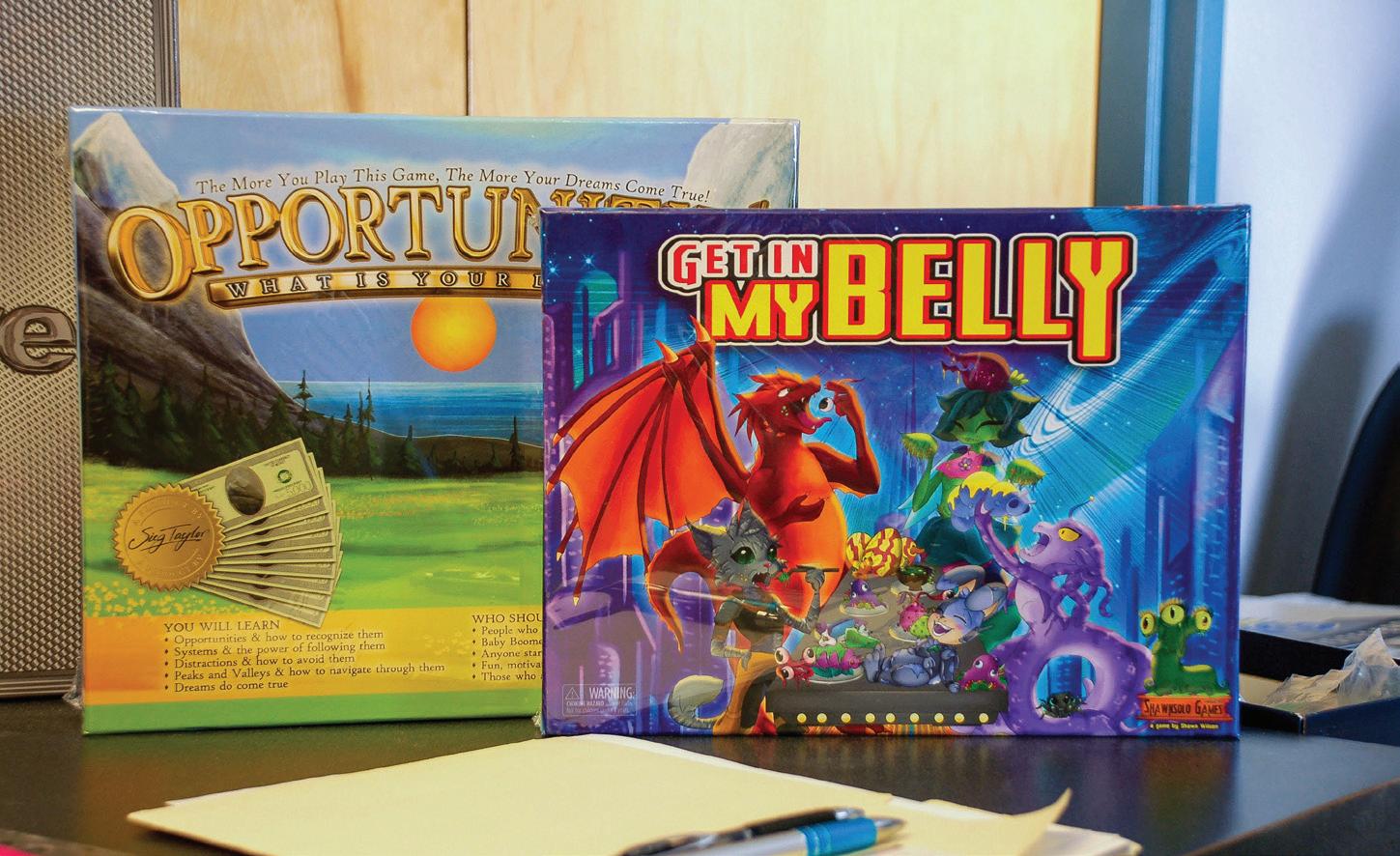
“One of the pluses of me being a game inventor and a graphic artist is that I’ve been through this,” Michael says. “When it comes to helping my customers, I can make a lot of suggestions and advise them on things they might want to consider.”
The global tabletop games market was estimated at $24.91 billion in 2022 and is projected to grow to $48.69 billion by 2028, according to market research company Arizton. Among the thousands of new games released yearly, Board Game Design and Manufacturing has contributed hundreds since its inception.
With hopes of eventually opening his own large-scale manufacturing building, Michael envisions expanding the company’s reach and impact. His business is a haven for emerging inventors.
As the CEO, owner, art director and webmaster, Michael prides himself on being able to offer services for anyone with a thoughtout concept. He advises aspiring game makers to play and test their games with as many people as possible and to choose a professional designer to create packaging that gives a great first impression.
“I enjoy doing this,” he says. “It’s a very rewarding job because one of the things that we’re doing is helping people to make their dreams come true.” n
Visit www.boardgamedesigns.com for more information on how to turn an idea into a board game.

By George Weigel
Plant prices have risen sharply the past two years. So have costs of insecticides, fertilizers, deer repellents, mulch, tools and other accessories gardeners use to keep their green investments alive. Even bagged dirt is no longer dirt-cheap.
What’s a gardener on a tight budget to do? Fortunately, this is one pastime that lends itself well to belt-tightening strategies. Let’s dig into specifics.
You could pay full price at prime planting time like most gardeners, or you could pay half or less with some bargainsniffing strategies. Start by looking for markdowns on overstocked, out-of-bloom or past-prime plants. These are often perfectly healthy, just not attractive enough to fetch top dollar.
Four top savers: Perennials relegated to a bargain rack after they have finished blooming for the season; annuals and vegetables that are still viable but unsold after the spring rush; trees and shrubs that are misshapen markdowns but fixable via pruning and patience; and tulips, daffodils and other spring-blooming bulbs that are often 50% off when unsold but still plantable by the end of October.
Get on your favorite garden center’s loyalty program. Many offer discounts, coupons, rewards and special sales to regular customers. While you’re at it, let local garden center managers know you’re interested in plants they want to clear out. You might get a call before plants go on the clearance rack—and maybe even year-end freebies.
Bargains are sometimes possible through mail-order and online vendors, but expect the plants to be small and bare root—shipped
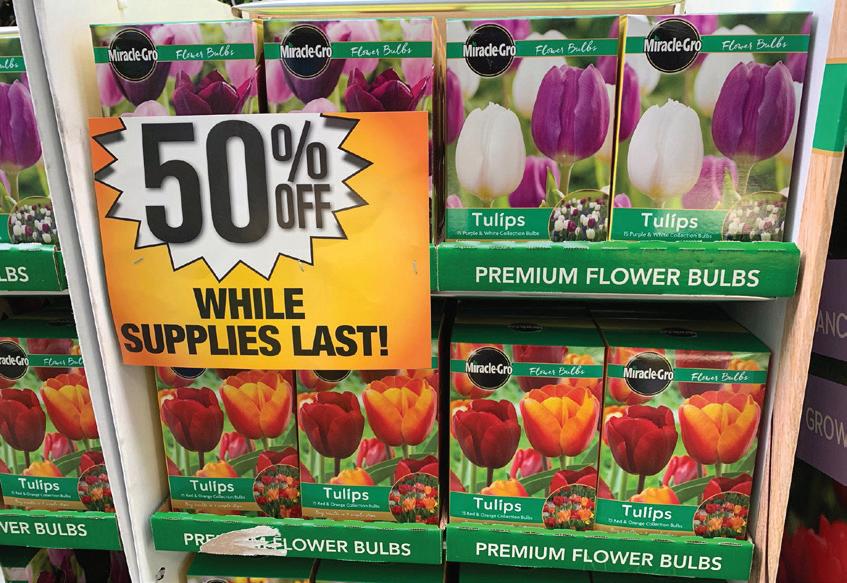

with weight-saving packing material around the roots instead of soil. Coddle them in a pot for a year to maximize success.
Plant bargains also can be found from unconventional sources, including plant societies, master gardeners, libraries, public gardens, farmers markets, schools and garden clubs—all of which often hold plant sale fundraisers using divisions from members’ yards, locally started seedlings and discounted greenhouse transplants.
You might also encounter plants at yard sales. These sometimes can be bargain-priced, dig-your-own gold mines. Just be careful you’re not buying someone else’s overly aggressive varieties.
Landscape companies are another overlooked plant resource. Landscapers routinely dig up healthy plants during renovations, simply because they have outgrown the space or a new homeowner doesn’t like them. They may let you salvage the vegetation instead of dumping it.
Wherever you buy plants, opt for less expensive, smaller sizes. Given patience and good growing conditions, a quart-sized perennial will end up at the same mature size as a gallon-sized one but at a significantly lower starting price.
Leaning small especially saves on trees, which can double in
Gardening can give a second life to all sorts of household junk, er, “resources.” Here are several items that can be retooled:
• Old shoes, baskets, backpacks, pocketbooks. Just about any worn-out item that can hold soil can morph into a plant container. Just be sure it has drainage holes.
• Vinyl blinds, plastic detergent bottles. Cut in strips with a point at one end and use as plant labels. Use a marker or wax pencil for writing.
• Dishes, glassware, vases, ceramics. Old, one-off and even cracked pieces can be crafted into garden ornaments.
• Newspaper, junk mail, office paper. All can be shredded and added to the compost pile.
• Empty milk jugs. Wash and reuse as plant protectors over young vegetable garden plants on cold nights. Or use the cut-off bottoms as seed-starting containers.
• Plastic soda bottles. Cut a vertical slit and wrap the bottles around young trees, shrubs and vines to protect them against rodent chewing.
• Margarine tubs, yogurt cups, egg cartons. Poke holes in the bottom and use them as seed-starting containers.
LEFT: Save money on plants by dividing perennials and planting from seeds.
RIGHT: Add a little humor and variety to your garden by repurposing old household items as plant containers.

• Plastic wrap. After food-bowl duty, save a few sheets to drape over seedstarting trays. It traps moisture like a mini greenhouse.
• Spray bottles. Rinse them well and use them to mist seed trays or tip cuttings. Or use them for spraying animal repellents.
• Used sandpaper. Staple strips of it to the tops of raised-bed boards or other wooden-bed edging to repel slugs, which detest crawling over scratchy surfaces.
• Old mailbox. Relocate it to the garden, where it can become a repository for markers, labels, string and all those other little things you forget in the garage.
• Old broomstick, left-over PVC pipe. Make a watering wand for reaching hanging baskets and window boxes by using metal hose clamps to secure your garden hose to them.




ground in the fall to overwinter and mine again next year.
A third pot money-saver is using double-duty plants. Most so-called houseplants—crotons, palms, snake plants, peace lilies, rubber plants, etc.—are tropical or subtropical species that do perfectly fine outside in northerly summers and inside over winter.
Consider using plants you bought as houseplants in summer pots, dressed up with coordinated annuals. Conversely, instead of discarding tropicals bought for summer pots at the end of the season, convert them into houseplants over winter.
The fastest way to save on gardening products is to cut out things you—and your plants—don’t need.
Some possibilities: wound dressings for pruned trees (not necessary and sometimes counter-productive); leaf shine (a soft, damp cloth with diluted soap cleans dusty houseplant leaves); compost activator (a few shovelfuls of finished compost or soil adds decomposition microbes); antitranspirant/antidesiccant sprays (somewhat helpful in transplanting, but research shows little to no cold-weather protection); moisture-holding gels for potted plants (research shows little to no water-saving benefit); landscape fabric (inhibits soil oxygen and traps moisture in poorly drained beds, plus weeds grow on top if you mulch over it), and tree fertilizer spikes (trees usually get the nutrients they need from soil, decomposing mulch and/or fertilizer on the surrounding lawn).
Next is reducing the amounts you use of products such as fertilizer.
Plants take up only the nutrients they need. Adding more doesn’t make them grow bigger or better and is a waste of money, not to mention potentially polluting.
If plants are growing well, there’s usually no need to add anything. If they’re not, a soil test reveals if lack of nutrition is a culprit—along
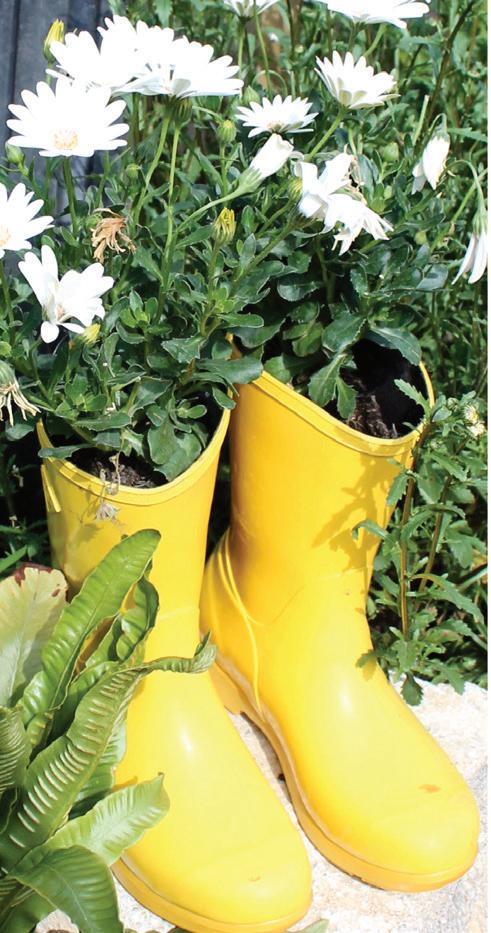
with exactly which nutrients are needed and in what amounts.
Extension offices and many garden centers offer inexpensive DIY soil-test kits to help you spend fertilizer dollars wisely.
Bug and disease sprays are another potential cost-saver. Some gardeners routinely use pesticides “just in case,” both wasting money and potentially killing beneficial insects that would have controlled pest bugs naturally—and at no charge.
Most bugs and diseases target only specific plants, and much of the damage is temporary or cosmetic anyway. Consider products only when plants are under threat from intolerable or potentially fatal damage—and when there are no better alternatives.
Sometimes, free or less expensive alternatives are available for other garden products. For example, an index finger stuck a few inches into the soil can give an accurate read on soil moisture versus investing in a soil moisture meter.
Expensive potting mix can be stretched by mixing your own from bulk ingredients or by refreshing last year’s saved mix with half-new mix, assuming last year’s mix wasn’t bug- or disease-ridden.
Many municipalities collect leaves in fall and offer the resulting free or low-cost compost to residents the following year, saving on bagged or bulk purchases. Tree companies often are willing to drop loads of chipped tree branches in home driveways, saving themselves hauling/dumping fees.
Even costly hardscaping materials such as bricks, stone, patio furniture, garden ornaments and fencing are sometimes available free or heavily discounted from neighbors advertising them through local social media channels.
Lots of household waste is fair game for repurposing in the garden, including storage tubs that morph into flower containers, cut-off soda bottles that serve as plant protectors, and butter tubs that become seedling pots. See the sidebar on page 13 for 20 household rejects that can serve new life in the garden. n





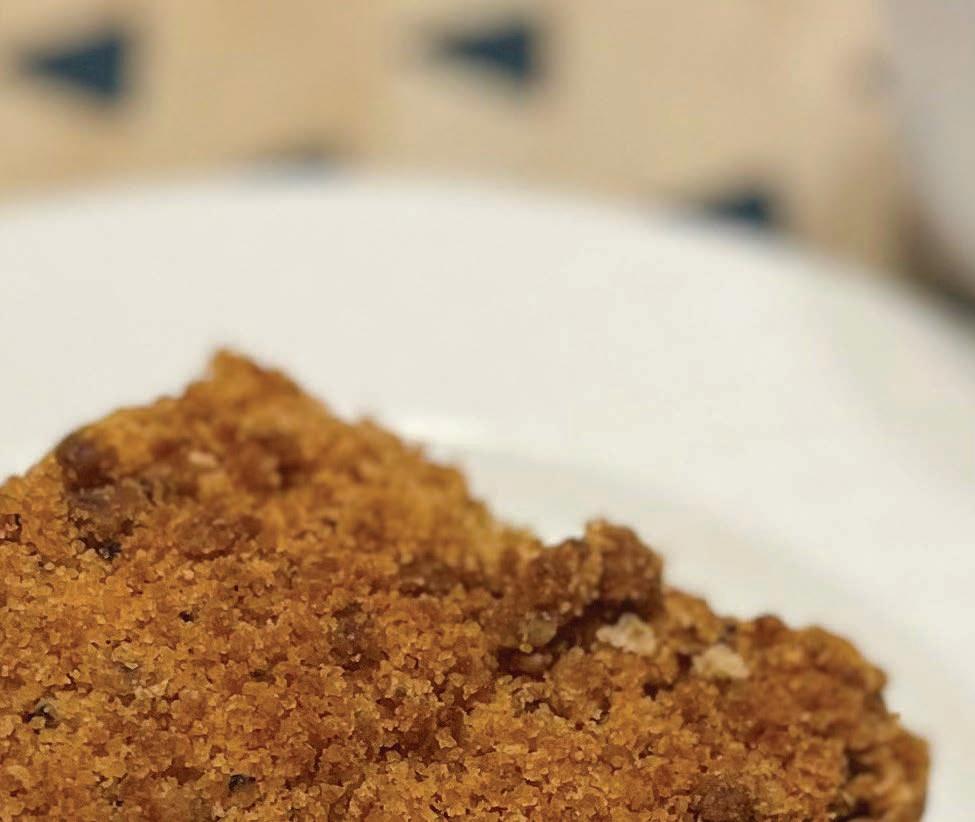







Coffee Coffee Cake
Crumb topping
½ cup all-purpose flour
¼ cup brown sugar
½ teaspoon ground cinnamon
½ teaspoon instant coffee powder
4 tablespoons butter, melted
Heat oven to 350 F.
Spray a 9-by-9-inch pan, and line with parchment. Spray the parchment as well.
For the crumb topping: In a medium bowl, mix the flour, brown sugar, cinnamon, coffee powder and salt. Add the melted butter. Mix until it forms crumbs that you can clump together in your hand.
For the cake: In a medium bowl, whisk together the flour, baking powder, baking



Cake
1¾ cups cake flour
¾ teaspoon baking powder
¾ teaspoon baking soda
½ teaspoon ground cinnamon
½ teaspoon salt
soda, cinnamon and salt. In a smaller bowl, whisk together the coffee and sour cream until smooth.
In the bowl of an electric mixer fitted with the paddle attachment, beat the butter and sugar together until light and fluffy. Add the eggs, one at a time, mixing until each is well-combined. Add the vanilla. Beat until the mixture is light and fluffy. Starting and ending with the dry


½ cup strong-brewed coffee
1⁄3 cup sour cream

1 cup butter, room temperature
1 cup granulated sugar
2 extra-large eggs
1 teaspoon vanilla extract

ingredients, alternate adding the flour mixture and the coffee mixture to the stand mixer. Mix well after each addition. Pour the batter into the prepared baking pan. Top with crumb topping, spreading it evenly. Bake for 45 minutes or until a toothpick comes out clean.
Remove the cake from the oven. Cool for 20 to 30 minutes before cutting and serving.


1 pound ground sausage
2 tablespoons flour
1 cup milk
1 cup water
¼ cup brewed coffee
Salt and pepper, to taste
Brown sausage in a cast-iron skillet. Add flour, and brown. Add milk and water. Simmer for desired thickness. Stir coffee into the mixture. If it’s too thick, add more milk. Season with salt and pepper. Serve over your favorite biscuits.
4 slices bacon, chopped
1 sweet onion, chopped
¼ cup vinegar-based barbecue sauce
Heat the oven to 350 F.
28-ounce can baked beans
¼ cup brown sugar
2 tablespoons Dijon mustard
¼ cup brewed coffee
Cook the chopped bacon in a pot over medium heat until browned, about 10 minutes. Remove the bacon with a slotted spoon, reserving the bacon grease in the pan. Drain the bacon on paper towels.
Add the chopped onion to the pot with the bacon grease. Cook for 15 minutes over medium-low heat or until caramelized. Remove the pot from the heat. Add the bacon back to the pot, as well as the remaining ingredients. Mix.
Pour the beans into a greased 8-by-8-inch baking dish. Bake for 2 hours. Let sit for 5 minutes before serving.
Cupcakes
1 cup sugar
½ cup brewed coffee, cold
½ cup canola oil
2 extra-large eggs, room temperature
3 teaspoons cider vinegar
Frosting
3 tablespoons milk chocolate chips
3 tablespoons semisweet chocolate chips
Heat oven to 350 F.
3 teaspoons vanilla extract
1½ cups all-purpose flour
1⁄3 cup baking cocoa
1 teaspoon baking soda
¾ teaspoon salt
1⁄3 cup butter, softened
2 cups confectioners’ sugar
2 tablespoons brewed coffee
½ cup chocolate sprinkles
In a large bowl, beat sugar, coffee, oil, eggs, vinegar and vanilla until well-blended. In a small bowl, combine flour, cocoa, baking soda and salt. Gradually beat into coffee mixture until blended.
Fill 12 paper-lined muffin cups three-fourths full. Bake for 20 to 25 minutes or until a toothpick inserted in center comes out clean. Cool for 10 minutes before moving to a wire rack to cool completely.
To make frosting: In a large bowl, melt chips and butter in a microwave. Stir until smooth. Gradually beat in confectioners’ sugar and enough coffee to reach desired consistency. Pipe frosting onto cupcakes, and add sprinkles.
2 tablespoons coarse salt
2 tablespoons instant coffee
2 tablespoons garlic powder
2 tablespoons smoked paprika
1 tablespoon black pepper
1 tablespoon crushed coriander
1 tablespoon onion powder
1 teaspoon chili powder
½ teaspoon cayenne, more or less to taste
Add all ingredients to a medium-sized bowl. Mix well. Once mixed, it can be used immediately. Store leftovers in an airtight glass container.
S’mores
1 cup whole milk
3 extra-large eggs, room temperature
2⁄3 cup sugar
1⁄3 cup baking cocoa
2 tablespoons strong-brewed coffee
2 tablespoons butter, melted
Heat oven to 325 F.
2⁄3 cup graham cracker crumbs
1⁄3 cup sugar
2 cups miniature marshmallows
1.55-ounce milk chocolate candy bar, broken into 12 pieces
In a small saucepan, heat milk until bubbles form around sides of pan. Remove from heat. In a large bowl, whisk eggs, sugar, cocoa and coffee until blended but not foamy. Slowly whisk in hot milk.
Place six 4-ounce broiler-safe ramekins in a baking pan large enough to hold them without touching. Pour egg mixture into ramekins. Place pan on oven rack. Add hot water to pan to within ½ inch of the top of the ramekins.
Bake 20 to 25 minutes or until a knife inserted in the center comes out clean. Centers will still be soft. Remove ramekins from water bath immediately to a wire rack. Cool for 10 minutes. Refrigerate until cold.
In a small bowl, mix butter and cracker crumbs. Set aside. To caramelize topping with a kitchen torch, sprinkle custards evenly with sugar. Hold torch flame about 2 inches above custard surface. Rotate it slowly until sugar is evenly caramelized. Sprinkle custards with crumb mixture, and top with marshmallows. Using the torch, heat marshmallows until browned. Top with chocolate pieces. Serve immediately or refrigerate for up to 1 hour.
To caramelize topping in a broiler, place ramekins on a baking sheet. Let stand at room temperature for 15 minutes. Heat broiler. Sprinkle custards evenly with sugar. Broil 3 to 4 inches from heat for 3 to 5 minutes or until sugar is caramelized. Sprinkle custards with crumb mixture. Top with marshmallows. Broil for 30 to 45 seconds or until marshmallows are browned. Top with chocolate pieces. Serve immediately or refrigerate for up to 1 hour.
Does anyone have an Annie’s Attic booklet called “Chemo Caps & Wraps,” number 871044? Thank you in advance. I am willing to purchase.
Betty Mercado
1820 E. 10th St. The Dalles, OR 97058 bettym@centurylink.net
We are trying to locate my grandfather’s high school yearbook. He graduated in 1930 from The Dalles Oregon High School. If anyone has it and is willing to sell, please contact me. Thank you so much.
Kim Koester
220 Well St. Fairbanks, AK 99701 skmeb08@gmail.com
I have started a tablecloth using my odds and ends of number 10 crochet cotton. Sadly, I have reached the end of my colored cotton. I am asking members if they can send me their odds and ends of colored crochet cotton number 10. The brighter the colors, the better. I will pay for postage.
Patty Gassner
39981 Gisler Road Scio, OR 97374
My widowed mother turns 100 in March. She has lived in Delaware her whole life but traveled to many places in the United States and abroad—including France, her favorite country and ancestral home. She shared her travel stories with the elementary school students she taught for decades. She says she doesn’t want a birthday reception at her assisted living facility, as her dear friends are long gone. I know she would be surprised and delighted to receive greetings from afar to celebrate her milestone birthday. Send to Julia A. Coxe, 726 Loveville Road, Room A-40, Hockessin, DE 19707.
Donna C. McLean Redmond, Oregon
Thank you, readers. Your generosity in sending so many wonderful and lovely buttons has wowed me. I will be at work for months making “button flower” vases as fast as I can to give away. My button table is full, thanks to your kindness.
Shirley Lyons Veneta, Oregon
Thank you, Ruralite, for helping to make my 90th birthday so memorable. I received more than 350 cards from readers—from Alaska to Georgia. I wish I could personally thank each of you for your birthday wishes. It is amazing how many kind people took time to send greetings to a stranger. Thank you for your generosity, and yes, I had (at least one) margarita on my birthday. Thanks again.
Marian Kuchle Florence, Kentucky
A great big “thank you” to everyone who sent me a birthday card. From handmade or otherwise, I so appreciated each and every one of them. Not only did I enjoy reading all the wonderful comments, but I also got a lesson in geography. It truly was a very memorable 82nd birthday.
Ilse Pettey Baker City,
Oregon
I would love to thank each and every one of you kind souls. The overwhelming response to my mother, Josephine’s, milestone was awesome. I helped her open and read each card. The personal messages, jokes and crafty gifts were so nice. My mother sends her love and thanks. She will be donating the cards to St. Jude’s and will keep the personally crafted ones for her scrapbook. I cannot thank you all enough. God bless.
Josephine
Formica/Dawn Lund Rachel, Nevada
Have a safe St. Patrick’s Day!
Send your request—no attachments, please—to readerexchange@ruralite.org or mail to Reader Exchange, 5625 NE Elam Young Parkway, Suite 100, Hillsboro, OR 97124. Fill in the subject line with Reader Exchange. Acceptance, scheduling and editing are at the editor’s discretion. Single requests only, please. No duplicates.
Submissions are handled on a first-come, first-served basis and as space allows. We cannot honor every request.
Please affirm you have authorization from all appropriate parties before submitting. By submitting, you indemnify Reader Exchange, Pioneer Utility Resources Inc., its officers, directors, employees, utility clients and insurers from all legal liability incurred by the publication of information.
We no longer accept pen pal requests. You may submit a pen pal request as a Marketplace ad. Marketplace pricing applies. When submitting a milestone request, please send it at least two months before the milestone. Phone numbers will not be published. Email addresses will be published if part of the ad, but you must include a postal address. Requests also must include the name and address of the electric utility that provides your magazine.


























Theirs sold at auction for $226,000. Ours is JUST $29! Curious? Read on!
To art nouveau jewelers at the turn of the last century, nothing was more beautiful than the dragonfly. In the dragonfly’s long body and outstretched wings, jewelers found the perfect setting for valuable stones. ese jewelers’ dragonfly designs have become timeless statements of style; a dragonfly pendant designed by French jeweler René Lalique recently sold at auction for $226,000. Inspired by his stunning artistry, we’ve crafted our Dragonfly Nouvelle Collection, an elegant jewelry set for JUST $29!


True artisanship in Austrian crystal and yellow gold. is necklace and earring set features gorgeous multicolored enamel paired with Austrian crystals and a yellow gold finish. Ask any jeweler and they’ll tell you it takes true artisanship to properly blend the blues and purples found in this enamel. While art nouveau dragonflies are hard to come by, we’re helping to repopulate their numbers with this artfully stylized depiction of some of nature’s smallest wonders!


Buy the pendant, get the earrings FREE. If Stauer were a normal company, we’d sell the necklace and earrings for $199 each, but because we engage the world’s best artisans and cut out the middlemen to sell directly to you, we’re offering the necklace for JUST $29! Even better: If you buy within the next few days, we’ll throw in the earrings for FREE! at’s a nearly $400 value for JUST $29!




Act fast! e first time we ran this jewelry in our catalog, it sold out in a matter of days. Get this collection now before this offer goes extinct!
Jewelry Speci cations:

• Enamel with Austrian crystal. Yellow gold finish
• Pendant: 1 ½" W x 1 ¼" H.
Chain: 18" + 2", lobster clasp. Earrings: 1 ¼" L, french wire
pendant, get earrings FREE! Dragonfly Nouvelle Collection
A. Necklace $199 $29* + S&P Save $170
B. Earrings $199 FREE with purchase of Dragonfly Nouvelle Necklace

*Special price only for customers using the offer code.












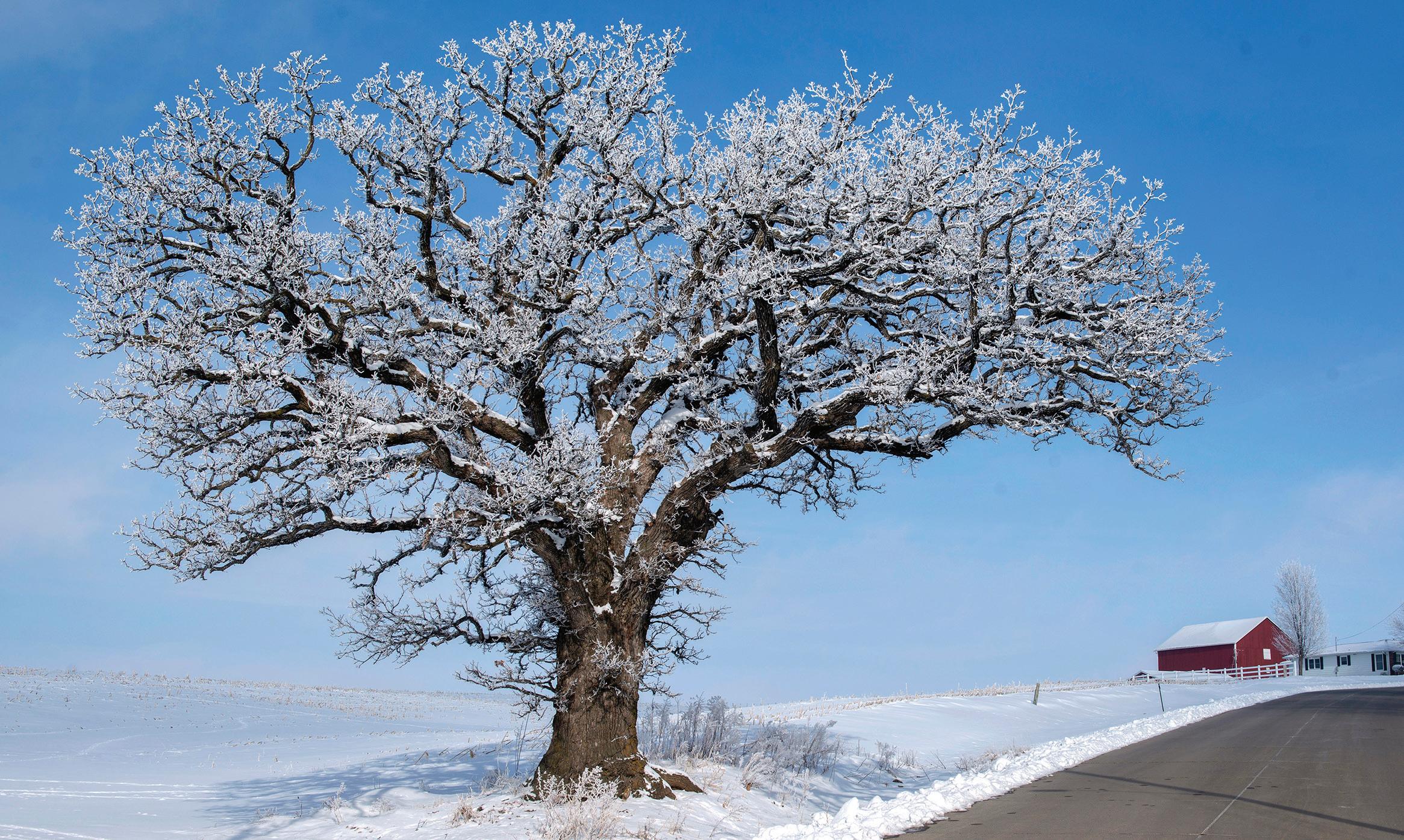
By Dave LaBelle
Some people are fascinated with architecture or angels; I love trees.
A grand lone oak tree stands—as if on watch—at the side of a road not many miles from where I live. Each time passing it, I wondered its age and who planted it there. Finally, my curiosity got the best of me, and I had to know more.
I learned the man who planted it is gone. So are his

children and his children’s children, but the old oak tree John Vorwald placed in the earth in 1895, as a marker for the northeast corner of the town that would become New Vienna, Iowa, still stands 128 years later. His great-grandson Kevin Vorwald still lives on the family property.
Kevin’s great-grandfather was the first mayor of the town when he planted the tree. Though New Vienna was founded in 1843, it wasn’t incorporated until some 50 years later, long after Iowa became a state in 1846. Kevin says his great-great-grandfather married a girl whose father bought the land from the government when James Polk was president. Polk’s name is on the deed.
Trees are living, breathing
gifts, and may possess greater memory and intelligence than we imagine. Research has revealed that like people, trees can have elaborate, far-reaching root systems that allow them to talk to each other.
Just like us humans, trees are connected and often members of large families.
I am reminded of the late Shel Silverstein’s powerful book, “The Giving Tree,” about the relationship between a boy and an apple tree. Every tree is a giving tree. Just as I imagine how lacking a world without birds would be, I think how sad our walk on Earth would be without trees. I have often said that next to a good mother, God’s greatest creation is a tree.
Had I not chosen photojournalism, I might have become an arborist. n
Your challenge is to choose a tree that speaks to you—one that you admire and maybe even feel a connection to. Research its species and origin. Was it indigenous or a species brought to your area, transplanted from another state or even another country? Does the tree have a story? And then set out to make a photograph that captures how you feel about the tree. Consider the angle, composition, light and lens, even the time of day or night that best reveals how you see this magnificent creation.
Email your best image (just one, please) with caption information, including an explanation of how it affects you, to GPH@pur.coop. We may share submissions on our website and social media channels.















































Oregon Trail Electric Cooperative provides safety training videos for member-owners, community groups and first responders. To learn more, call OTEC’s safety manager at 541523-3616. IMAGE COURTESY OF OTEC
Oregon Trail Electric Cooperative reminds you to always keep electrical safety in mind, especially around downed power lines.
Overhead power lines carry thousands of volts of electricity. If a line is down, always assume it is energized and dangerous, even if the power is out in your area. Touching or getting near a live power line can injure or even kill you.
Never approach an accident scene where a line is down or damaged. You could become a victim if you enter the energized area.
Power lines can fall down or sag close to the ground for a few reasons, including severe weather or damage due to a car accident. Remember, a downed power line isn’t always visible. After severe weather, lines can lurk underneath water or debris or could be tangled in fallen trees.

Stay clear—at least 50 feet—of all types of utility lines. Even if you think the lines might be telephone or cable service lines, they may be dangerously energized from touching power lines.
OTEC offers these additional safety reminders: Call 911 to report downed power lines or damaged
Power lines do not have to be arcing, sparking or making a humming noise to be live.
Do not attempt to move a downed line or anything it is touching.
Do not attempt to drive over a downed power line.
If a power line falls on your vehicle, do not attempt to drive away or get out of the vehicle. Call 911 for help and stay inside the vehicle until utility crews say it is safe to get out.
• Any power line that is dead could become energized at any moment due to power restoration or backfeed from backup generators, so stay at least 50 feet away.
• Always consider all lines, regardless of the type, to be energized at deadly voltages.
For more information about electrical safety, visit otec.coop/safety.
Reinforced custom-sized pond liners (39 cents/sqft). Hay covers, greenhouse covers, any width and length. Truck tarps and more. High puncture and tear strength. Best price guaranteed. Celebrating 42 years in business. www.btlliners.com. 541-447-0712. 0424
305-gallon Norwesco water storage tank, $285. Clean, used. Excellent condition. Black poly 4 ft. tall by 4 ft. diameter, 59 lbs. Elko, NV. 775-275-0746. 0324
1993 Charmac horse trailer, $2.5K OBO. 3 Apache salt/pellet feeders, $2K each OBO. Aluminum pickup box, new, $150. Large recliner/incliner, like new, $400. 2-piece fireplace hearth, nice, $100. 541-893-6292. No late calls.
4x5 round bales, Meadow Foxtail Orchard Grass. 4x4 Timothy, small square. nas@cpcinternet.com; 208-435-4637 or 208-435-4002. 1224
Buying antiques and collectibles: advertising signs, porcelain signs, gas pumps, beer signs, antique toys, cast-iron coin banks, neon signs and more. Jason, 503-310-3321 or tjabaughman@yahoo.com. 0324
Buying American Indian collectibles, Navajo blankets and rugs, baskets, beadwork, etc. Also, quality paintings of the early Southwest and Americas. Call 760-409-3117 or send photos to amer.ind.baskets@gmail.com. 0524
WC Collectibles. We buy comic books! Local to the Inland Northwest, willing to travel. WCCollectiblesCheney@gmail.com; 509-496-1835. 0724
More “Montello Remembered” novels available. I’m also liquidating my NV history collection. Many rare and hard-to-find books now available. pruitt2010@frontier.com; 775-753-3254. 0324
Quaint hardware store in Maupin, OR, for sale. Inventory and interior store recently updated and refreshed. See ad on Bizbuysell.com or email Maupincountrystore@gmail.com. $309K.
Looking to purchase small business in Northern Idaho. Call or send information on any opportunities. Can do a quick purchase. 559-269-5554; mike@rouchbuilders.com. 0324
Ads 25 words or fewer are $35 a month. An extended ad of up to 35 words is $50 a month. Contact information is included in the word count. Phone numbers and emails count as one word.
Longer ads may be placed. Contact 503-357-2105 or info@pioneer.coop for pricing information.
Ads are for customers of member co-ops, public utility districts and municipals only. Subscribers and nonmembers may inquire about pricing at 503-357-2105 or info@pioneer.coop.
Ads must be direct and in first person, and are subject to approval and editing.
Closing deadlines (in our office): May issue—March 29, 2024.
If submitting ad by mail, send appropriate payment with your name, address, email, phone number and the name of the electric utility that provides your magazine to: Marketplace, P.O. Box 1306, North Plains, OR 97133. Make check or money order payable to Ruralite.
We accept credit card payments for ads submitted by email. Send ad to info@pioneer.coop.
Call 503-357-2105 to pay by credit card.
Advertisements are accepted in good faith. Pioneer Utility Resources is not liable for interactions between buyers and sellers.
8th annual Fiber Arts and Jewelry Exhibit at Art Center East in La Grande, OR. Feb. 2March 30, 2024. artcentereast.org. 0324
Annual Quilt and Needlework Show. April 5-6 in Pahrump, NV, at Bob Ruud Community Center. Presented by Shadow Mountain Quilters. Shadowmountainquilters.com. 0324
Free materials—church, government uniting, suppressing “religious liberty,” enforcing National Sunday Law. Be informed. Need mailing address only. TBS, P.O. Box 374, Ellijay, GA 30540. 888-211-1715; tbsmads@yahoo.com. 0424AR
Publisher for Kodiak Daily Mirror, a 5-day publication located in Kodiak, AK. Responsibilities include all aspects of efficiently operating a daily newspaper. The right candidate is expected to get involved in the community. If interested, contact Virginia Farmier, vfarmier@newsminer.com or 907-459-7511. 0324
Local commercial fisherman sells summer catch of preserved freshness by blast freezing at sea, gourmet canned tuna on internet. Sept.June. 100% guaranteed the best canned tuna you ever tasted. Original, jalapeno and garlic flavors available. Twofisherstuna.com. Call 206-799-1082 to place your order. 0324
Alaskan yellow cedar. Great for planter boxes, herb and flower beds, fencing or decks. Various sizes available. Pete, 541-206-0727. Lisa, 541-747-5025, ext. 21. 0624
Granite cemetery markers at affordable prices. Will ship to most places. Joe, 541-815-8906 or highdesertmemorials@gmail.com; and www.highdesertmemorials.com.
Looking for stud services for 2-year-old female borgi in late April-early May. Black-and-white borgi or miniature/small full-bred border collie preferred. Willing to pay a stud fee and travel if necessary. Suzi Smith, 775-233-7242 or suzicooksmith@outlook.com.
Mini-goldendoodle puppies. Excellent companion dogs. 3 males; ready for forever homes Feb. 14. 15-20 pounds full grown. Asking $1K OBO. solomonstephans@gmail.com or 541-332-7101. 0324
Lake front home Eagle Lake, CA. 3-bd, 2-ba, 2-car garage, fully furnished and stocked, move-in ready, docks, boat lift. $299K or trade? 775-771-5263 or bdl1962@gmail.com.
$600K interior Alaskan turnkey roadhouse and 2 dry cabins. Well-maintained on 5 acres with pond. 50 scenic miles south to Denali Park entrance. 907-460-9292. 0524
Let me help you buy or sell ranch, farm and recreation property in Oregon. Fourthgeneration Oregonian, ranch owner. For sale: Sisters, OR, 40 acres. $1.7M. John Gill, 541-480-9161 or johngill@landandwildlife.com. Land And Wildlife brokerage. 0324
23 acres east of Cottage Grove, OR. 8 acres flat pasture, 15 acres forested hillside. 2 cabins, well, tractor, shed, firefighting equipment. City water, electricity. Quiet, secluded, views. Photos on request. $450K. hannond@comcast.net. 0424
Canyon City home w/basement. 2-bd., 1-ba., fenced yard, circular driveway, garage w/ workshop. $240K. Duke Warner Realty, 541-987-2363 or ddwr@ortelco.net. 0324
Columbia Gorge National Scenic Area, Dallesport, WA. 1,608-sqft. mobile home for sale in park. $670 monthly rent. Excellent condition. Professional upgrades. Motivated seller. $109K. 503-396-1251. 0424
4 well-maintained 1,200-sqft. cedar homes with huge decks on year-round creek. 2.12 acres. Close to small town of Selma, OR. $875K. 541-597-2185. 0424
Off-grid homestead. Ideal for wind/solar power. NE Elko County, NV. Has equipment, quarters, shop. Year-round access. Water and power nearby. $35K. geopup58@gmail.com. 0324
Recreational Rentals
Wavecatcher: Oceanfront. Central Oregon coast. Summer $175/night mid-May to midOct.; $140/night mid-Oct. to mid-May. (plus cleaning/tax). Three rooms w/double beds. Pets welcome. Wavecatcherbeachrentals.com. Reservations: 541-740-2846. 0324AR
Bend country cabin. Very clean and fully furnished cabin on private ranch. Close to recreation areas. Very nice. $95/night. 541-382-3050; bendcountrycabins@gmail.com. 0424
Recreational Vehicle
Hook up a steelhead at The Hook Up RV Park in Ahsahka, ID. Daily or longer rents available. 208-391-2919; hookuprvpark@gmail.com. 0324
Dawn Till Dusk Masonry. Brick, block, stone and pavers. Small jobs and repairs welcome. Check out our website at dawntillduskconstructionmasonry.com. 541-388-7605 or 541-410-6945. License No. 245760, bonded and insured. 0324
Quarkdesign. A small business for small business. Web and print design, advertising, collateral, web video and audio. Personal websites also. $40 per hour. quarkdesign.com. 0324
Call Pahrump Lock and Safe for all your residential, commercial and safe services. 24-hour emergency service in Pahrump, NV. 702-379-8441; Jim@pahrumplockandsafe.com. 0624
Wanted: Small, working oven element for a 1967-ish flair, double wall oven. 15 inches long, including 3-prong plug-in, 10.5 inches wide. 541-256-0990. 0524
Buying American Indian collectibles, Navajo blankets and rugs, baskets, beadwork, etc. Also, quality paintings of the early Southwest and Americas. Call 760-409-3117 or send photos to amer.ind.baskets@gmail.com. 0524
Gold, silver, coins/currency, buy, sell. Collections wanted. Fair prices paid. 44 years in retail store. Baker City, OR. 800-556-2133; garrymclin@aol.com. 1024
Old carpenter tools, planes (wood/metal), levels, chisels, slicks, adzes, axes, hatchets, handsaws, old rulers, spoke shaves, wrenches, shipwright tools, old tool chests. 503-659-0009 or 971-666-0659. 0324
Need to buy one copy of “Morrow County History Book” in good condition, published in 1983. Hard cover, 9 inches by 11.5 inches, dark green color with gold agricultural design inset on front. Ione, OR. L8ucy5T@gmail.com; 541-422-7495. 0424
Wanted: early Corvette ’58-’62, any condition. Call/text Randy, 503-544-3807. 0824


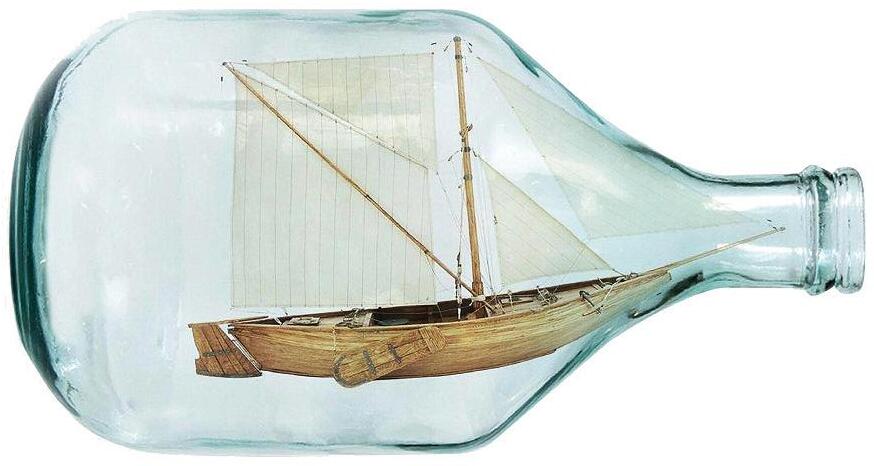

annually in scholarships through the OTEC Member Foundation. OTEC scholarships benefit OTEC member-owners and our communities. These funds are awarded to individuals from the OTEC service territory to help them pursue their educational goals.
One exciting academic scholarship opportunity is the OTEC-EOU Rural Scholarship. In partnership with Eastern Oregon University, OTEC annually awards four scholarships that cover all tuition and fees for four years at EOU.
OTEC recognizes that education and training are not one-size-fits-all. Not every young person wants or needs to attend a traditional four-year college, and many are recognizing the benefits of other types of skills training and certification programs.
“We’ve seen a shift in the last few years where there is such a lack of trained skilled workers, which has resulted in a demand that has driven up wages in many industries,” Baker Technical Institute President Doug Dalton says. “We now have the average skilled labor job paying more than the average bachelor’s degree job.”
we have programs and services for students that meet the needs, it helps us all thrive. To me, that is the goal for a good education system: that we know our kids—we know their face, we know their story, we know their situation, we have targeted supports, we have good classroom instruction.”
Erin Lair, superintendent of Baker School District 5J, says education is the foundation of a thriving rural community and economy.
“More often than not, the local school districts are the largest employer in their rural community,” she says. “Jobs in education provide stability, benefits and


Institutions such as BTI work with industry leaders to understand their workforce needs and provide the necessary skills training. This type of education provides new career opportunities for many in fields they may not have considered before. OTEC supports this avenue of education through scholarships to trade and lineworker schools.
Between a baby’s first book and the decision to attend college or pursue a career are many years of primary and secondary education, which, for most of us, are achieved in the public school system. Time spent in schools shapes our personalities, our learning habits, how we interact with others and much more.
“Education should be a strength of the community,” says George Mendoza, superintendent of La Grande School District. “When we do a good job of understanding the needs of students and


opportunity to be connected to families.”
Erin points out the importance of having good facilities, not only for the sake of the students’ learning environment but also for staff. In fact, according to the Oregon Department of Education’s Annual Report Card (2021-22), Oregon’s school buildings are, on average, more than 40 years old, making them more costly to maintain than newer buildings.
“In times of recession when school budgets get reduced, any funding dedicated to facilities that does exist is often a top consideration for ways to address funding gaps,” Erin says. “This includes both ongoing, annual maintenance in addition to capital projects. There is a strong body of research pointing to the impact maintained and up-to-date
buildings have on students’ capacity for learning. From actual height of ceilings, colors on walls and floors, windows and HVAC systems, all of these pieces play a huge role in student and staff experience.”
Erin and George point out the importance of health services in schools, including mental health and behavioral health services. For some students, school may be the only opportunity they have to access these vital services.
George says the district employs many resources to improve staff satisfaction and wellness as well.

“We want our staff to be seen, heard, understood, validated and supported,” he says.
In addition to dedicated support services for staff, the district offers many activities designed to bring staff together and build community in individual schools as well as across the district. Many things may have changed in the history of America, but the need to provide quality education for future generations of children remains important.

Just as 20th-century modernization brought new tools to workers in almost every industry, it also demanded a workforce that was educated to implement those tools. Innovations are once again demanding workers with new skills. It is up to all of us to prepare our children and grandchildren to meet these demands.
Having quality education systems in our communities is vital to the health of our communities. For new families or businesses looking to move, schools are often one of the first things they research. Supporting and investing in improvements to our education systems is investing in the health and future of our communities. n
Learn more about Dolly Parton’s Imagination Library at otec.coop/dolly-parton-imaginationlibrary. Learn more about all of OTEC’s scholarship programs at otec.coop/ scholarships.

As we continue celebrating 70 years publishing Ruralite magazine, let’s take a look back at a few snippets from a section of the publication called “For the Curious Ruralite” from the December 1954 edition. This was the first edition that carried the Northwest Ruralite masthead.
Low-Cost Water Purifier
A new water sterilizer for rural homes is moderately priced, says Elenite Products Inc. Ultra violet light kills the germs. The gadget is about the size of a table model TV set and sells for as little as $295 for the 100 gallon an hour size.
Apple Stops Spuds Sprouts
One apple stored in a sealed bag of spuds
will keep latter from sprouting, says Ohio State University Expert. Under such conditions, a ripe apple exudes ethylene gas which impedes sprouts.
Step Saver
Absent-minded drivers can now buy a buzzer designed to hook onto the gas gauge and the ignition under the dash. Buzzer buzzes when tank float drops to three-gallon level. “Gas-o-larm” is made by Talco Engineering Co. of Hamden, Conn. for $4.95.
New Fast Film
Eastman Kodak’s new “Tri-x” is supposed to be twice as fast as super double X. Said to cost no more.
43/4-inch Bacon
Wilson $ Co., meat packers are putting out short strip bacon cut to fit the frying pan. n
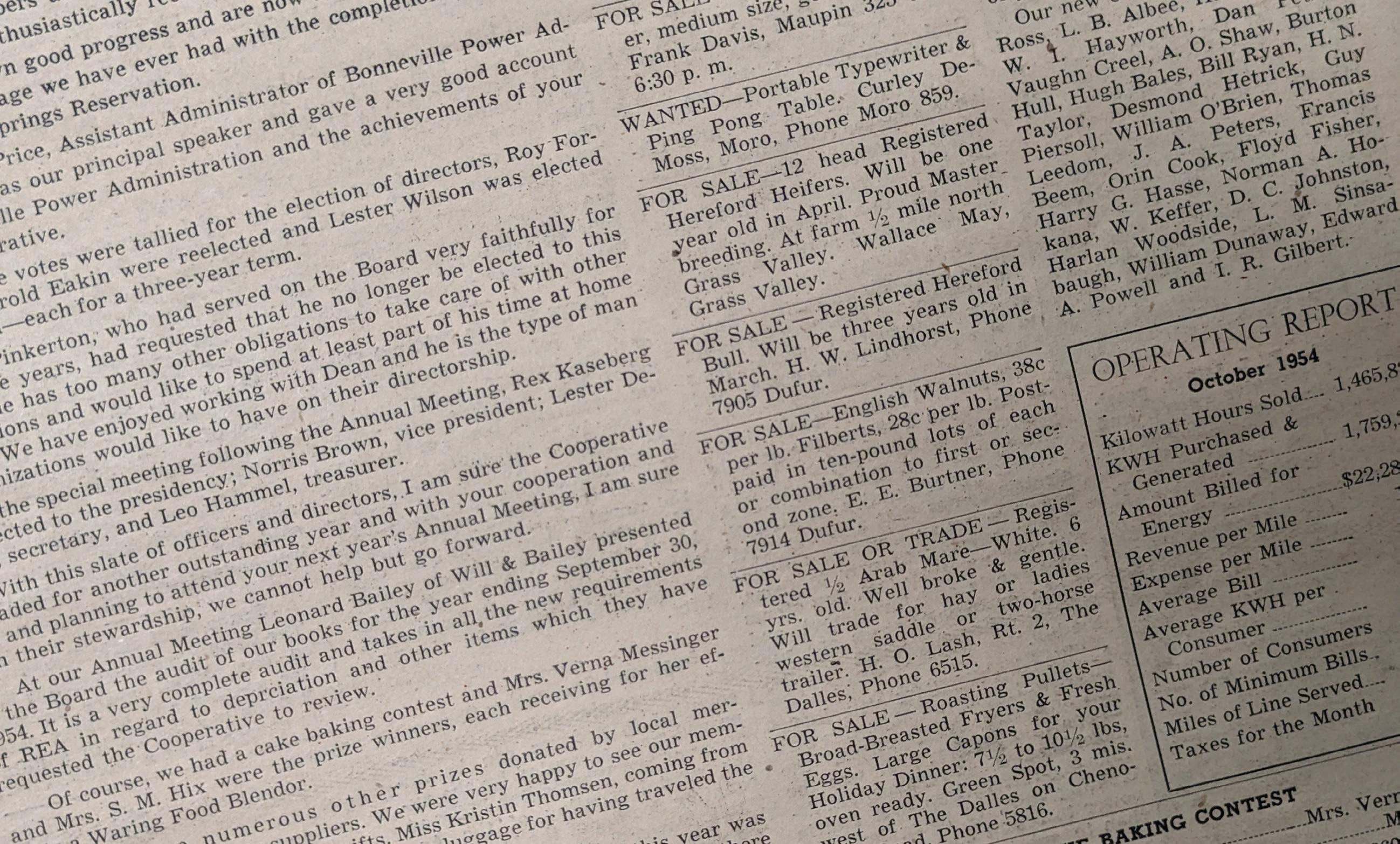




CHILD HUNGER CAN BE HARD TO RECOGNIZE. BECAUSE THE 1 IN 7 AMERICAN KIDS FACING IT CAN LOOK LIKE ANYONE. ESPECIALLY ME. I AM THE 13-YEAROLD BOY WHO GETS INTO FIGHTS AT SCHOOL, NOT BECAUSE I’M A BULLY, BUT BECAUSE I’M HUNGRY I AM THE 2-YEAR-OLD GIRL WHO CRIES ALL NIGHT NOT BECAUSE I’M SICK, BUT BECAUSE I WENT TO BED WITHOUT ENOUGH TO EAT. I AM THE 9-YEAR-OLD BOY WHO HOPES A FRIEND INVITES ME TO A SLEEPOVER NOT FOR FUN, BUT JUST SO I CAN HAVE DINNER I AM THE 15-YEAR-OLD GIRL WHO GOES FOR WALKS OVER LUNCH, SO MY FRIENDS WON’T KNOW I DON’T HAVE ANYTHING TO EAT. I WAS CREATED BY ARTIFICIAL INTELLIGENCE FROM PHOTOS OF THE 11 MILLION KIDS STRUGGLING WITH HUNGER IN THIS COUNTRY. A FACE THAT CHALLENGES YOU TO SEE HUNGER IN A DIFFERENT LIGHT. I AM WHAT HUNGER LOOKS LIKE IN AMERICA LEARN MORE AT IAMHUNGERINAMERICA.ORG , , .















